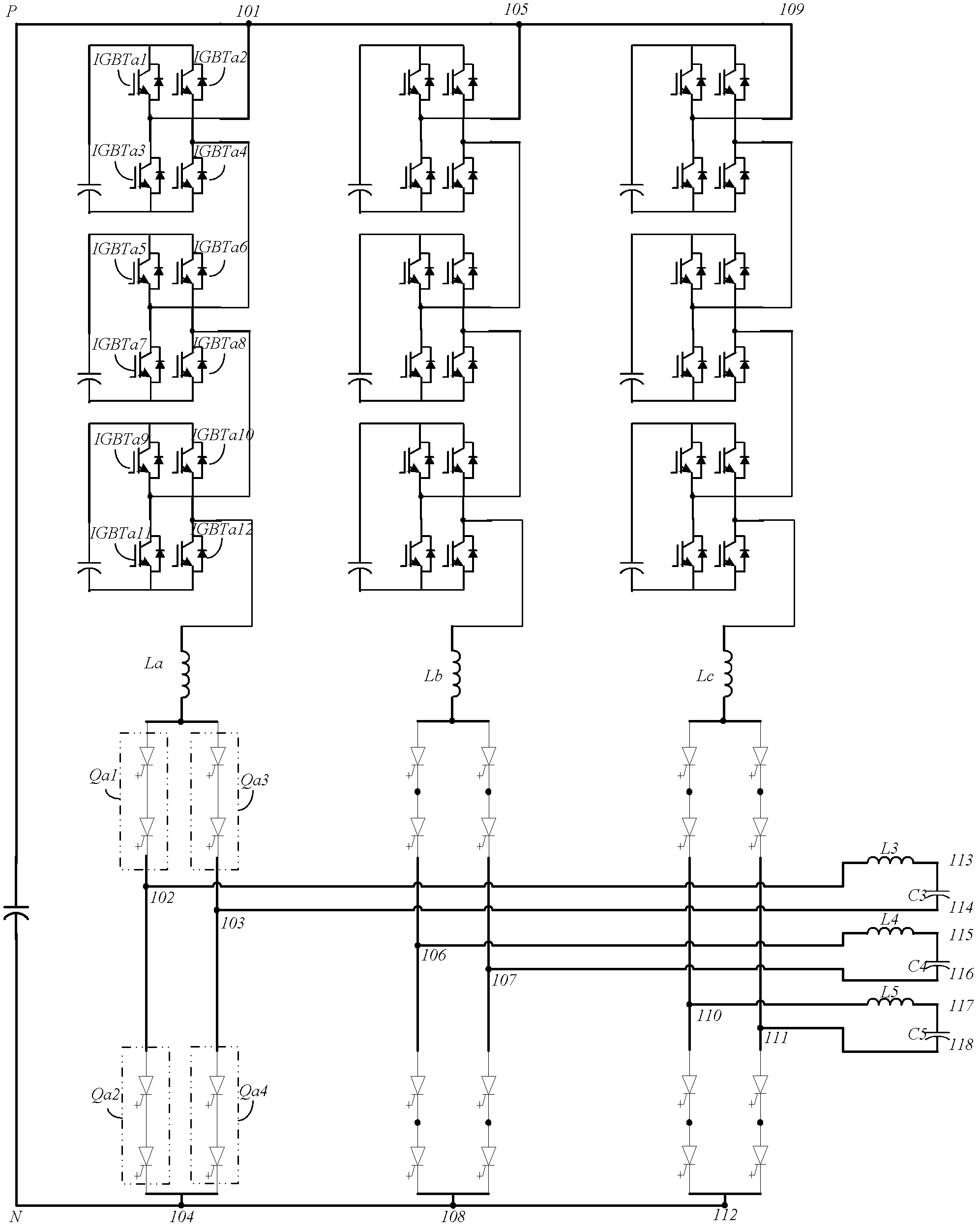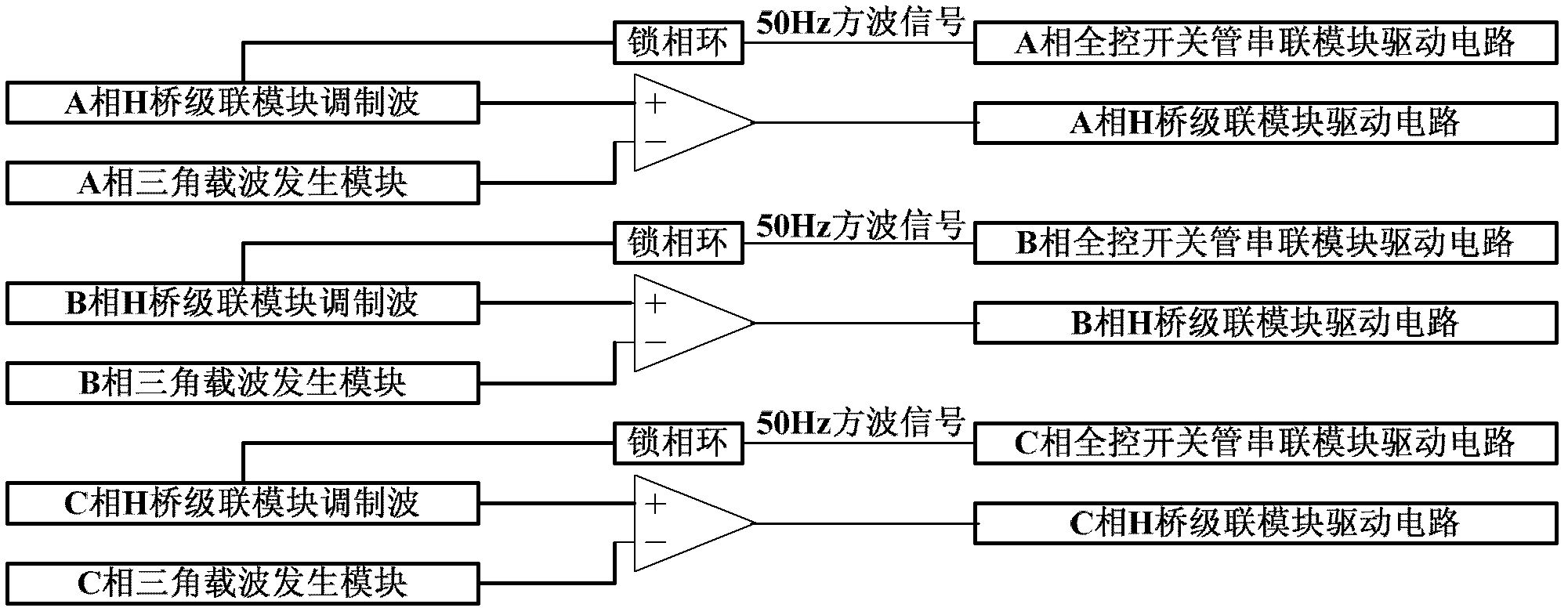Hybrid multi-level current transformation topology based on H full-bridge subunit and control method of hybrid multi-level current transformation topology
A hybrid multi-level and sub-unit technology, applied in the direction of converting AC power input to DC power output, electrical components, output power conversion devices, etc., can solve the problem of large loss, high DC bus voltage level, complex control cascade H Bridge structure and other issues to achieve the effect of reducing system loss and system cost
- Summary
- Abstract
- Description
- Claims
- Application Information
AI Technical Summary
Problems solved by technology
Method used
Image
Examples
Embodiment 1
[0047] figure 1 Shown is the circuit schematic diagram of the embodiment of the hybrid multi-level converter topology based on the H full-bridge subunit of the present invention. The hybrid multi-level converter topology of the present invention includes: a DC bus, a single-phase converter circuit structure, and an LC low pass filter. One end of the H-bridge cascade module is connected to the positive DC bus, and one end of the full-control switching tube series module is connected to the negative DC bus. The single-phase inverter circuit structure includes H-bridge cascaded modules, connected inductors, and full-control switch tube series modules. The H-bridge cascade module is composed of n full-bridge subunits cascaded. The full-control switch tube series module consists of four bridge arms with the same structure to form an H-bridge circuit structure. In the H-bridge circuit, the first bridge arm of the full-control switch tube series module and the third bridge arm of t...
Embodiment 2
[0069] figure 2 Shown is a structural schematic diagram of a three-phase multi-level converter based on the single-phase converter topology of the present invention, including: a three-phase shared DC bus, three single-phase converter circuits, and a three-phase LC filter circuit. The three single-phase inverter circuits work on the same principle, and output a sine wave AC voltage with a mutual difference of 120 degrees. The topological structure of each single-phase converter circuit is the same as the single-phase converter topology in Embodiment 1 above. The first lead-out terminal 101 of the A-phase converter circuit, the first lead-out terminal 105 of the B-phase converter circuit, and the first lead-out terminal 109 of the C-phase converter circuit are connected to the positive DC bus P. The second lead-out terminal 104 of the A-phase converter circuit, the second lead-out terminal 108 of the B-phase converter circuit, and the second lead-out terminal 112 of the C-pha...
specific Embodiment
[0071] As a specific embodiment of a high-voltage high-power converter based on the H full-bridge power subunit of the present invention, the specific control method is as follows:
[0072] The control methods of phase A, phase B, and phase C are the same as the single-phase inverter topology described in Example 1, and the overall control method is as follows image 3 As shown, the modulation wave of the A-phase H-bridge cascade module is compared with the A-phase triangular carrier generation module, and the output modulation signal is sent to the drive circuit of the A-phase H-bridge cascade module, and the modulation wave of the A-phase H-bridge cascade module is output through the phase-locked loop The 50Hz square wave is sent to the A-phase full-control switch tube series drive circuit; the B-phase H-bridge cascade module modulation wave is compared with the B-phase triangular carrier generation module, and the output modulation signal is sent to the B-phase H-bridge casc...
PUM
 Login to View More
Login to View More Abstract
Description
Claims
Application Information
 Login to View More
Login to View More - R&D
- Intellectual Property
- Life Sciences
- Materials
- Tech Scout
- Unparalleled Data Quality
- Higher Quality Content
- 60% Fewer Hallucinations
Browse by: Latest US Patents, China's latest patents, Technical Efficacy Thesaurus, Application Domain, Technology Topic, Popular Technical Reports.
© 2025 PatSnap. All rights reserved.Legal|Privacy policy|Modern Slavery Act Transparency Statement|Sitemap|About US| Contact US: help@patsnap.com



